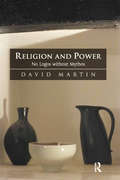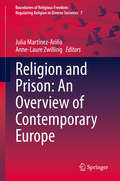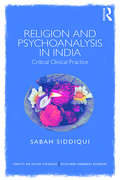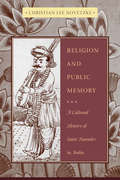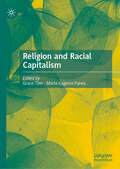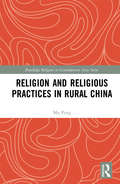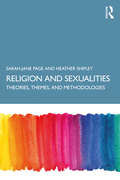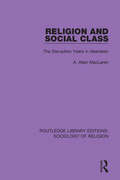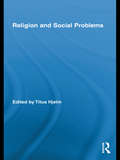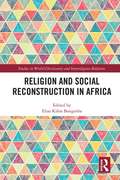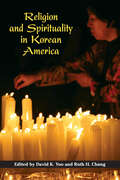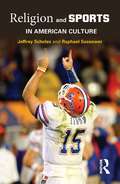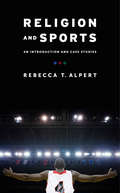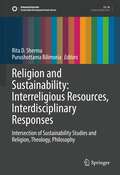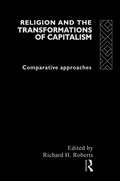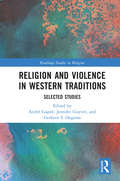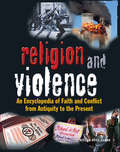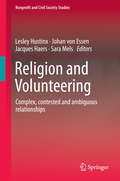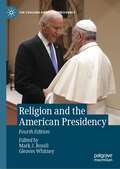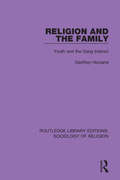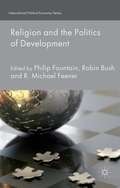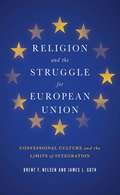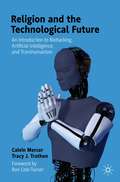- Table View
- List View
Religion and Power: No Logos without Mythos
by David MartinThere are few more contentious issues than the relation of faith to power or the suggestion that religion is irrational compared with politics and peculiarly prone to violence. The former claim is associated with Juergen Habermas and the latter with Richard Dawkins. In this book David Martin argues, against Habermas, that religion and politics share a common mythic basis and that it is misleading to contrast the rationality of politics with the irrationality of religion. In contrast to Richard Dawkins (and New Atheists generally), Martin argues that the approach taken is brazenly unscientific and that the proclivity to violence is a shared feature of religion, nationalism and political ideology alike rooted in the demands of power and social solidarity. The book concludes by considering the changing ecology of faith and power at both centre and periphery in monuments, places and spaces.
Religion and Prison: An Overview of Contemporary Europe (Boundaries of Religious Freedom: Regulating Religion in Diverse Societies #7)
by Julia Martínez-Ariño Anne-Laure ZwillingThis volume offers a European overview of the management of religious diversity in prisons and provides readers with rich empirical material and a comparative perspective. The chapters combine both legal and sociological approaches. Coverage for each country includes historical background, current penitentiary organization, and recent changes or trends. In their exploration of legal aspects, the contributors look at such factors as the status of prison chaplains and regulations concerning religious practice and religious freedom. These include meals, prayers, and visits. The sociological analysis examines religious discrimination in prison, church-prison relations, conversion and proselytism, and more. The European coverage includes countries for which such information is seldom available. The book offers readers a better understanding of governance of religion in prisons. This text appeals to students, researchers and professionals in the field.
Religion and Psychoanalysis in India: Critical Clinical Practice (Concepts for Critical Psychology)
by Sabah SiddiquiReligion and Psychoanalysis in India questions the assumptions of an established scientific, evidence-based global mental health paradigm by examining the practices of faith-based healing. It proposes that human beings demonstrate a dual loyalty: to science as faith and faith as science, both of which get reconfigured in the process. In this particular context, science and faith are deployed in ways that are not only different but at times contrary to mainstream discourses of science and religion, and faith healing becomes a point where these two discourses collide head-on in negotiating cultural values and practices. The book addresses key questions, such as: What is the value of 'faith healing' in understanding distress and treatment in different cultural contexts? What is a critical psychological perspective on faith and religious systems? What challenges do alternative religious practices pose to critical psychology? How should we re-imagine clinical work in a context marked by science and religion? Situated between 'West' and 'East', between the global mental health movement and local faith-based practices in India, the book addresses a wide audience that includes students and researchers in psychology, cultural and medical anthropology, the sociology of religion, cultural theory, postcolonial theory, and the sociology of science. It will also appeal to policy-makers and practitioners interested in the work of NGOs and the legal frameworks driving mental health movements in India.
Religion and Public Memory: A Cultural History of Saint Namdev in India
by Christian Lee NovetzkeNamdev is a central figure in the cultural history of India, especially within the field of bhakti, a devotional practice that has created publics of memory for over eight centuries. Born in the Marathi-speaking region of the Deccan in the late thirteenth century, Namdev is remembered as a simple, low-caste Hindu tailor whose innovative performances of devotional songs spread his fame widely. He is central to many religious traditions within Hinduism, as well as to Sikhism, and he is a key early literary figure in Maharashtra, northern India, and Punjab. In the modern period, Namdev appears throughout the public spheres of Marathi and Hindi and in India at large, where his identity fluctuates between regional associations and a quiet, pan-Indian, nationalist-secularist profile that champions the poor, oppressed, marginalized, and low caste. Christian Lee Novetzke considers the way social memory coheres around the figure of Namdev from the sixteenth century to the present, examining the practices that situate Namdev's memory in multiple historical publics. Focusing primarily on Maharashtra and drawing on ethnographies of devotional performance, archival materials, scholarly historiography, and popular media, especially film, Novetzke vividly illustrates how religious communities in India preserve their pasts and, in turn, create their own historical narratives.
Religion and Racial Capitalism
by María Eugenia Funes Grace TienMuch of the discourse around diversity, equity, and inclusion have encountered two blind spots. First, discourse in the academy and beyond have prioritized the intersectionality of race and gender but neglected the intersectionality of race and class. Secondly, the resurgence (and now backlash) to diversity, equity, and inclusion have largely benefited cultural and economic elites on the political left and left behind the working class. This book suggests that the framework of racial capitalism can help bring attention to these gaps, in part due to renewed scholarly interest in racial capitalism across academic disciplines. This edited volume is largely motivated by the above gaps in academic and mainstream discourse and makes two primary contributions: first, we examine the unique intersection of religion and racial capitalism, and second, we analyze case studies of racial capitalism in country contexts outside of the U.S., drawing on case studies from North America, South America, Europe, and Asia. Scholars, particularly historians, have largely examined racial capitalism in the U.S. context. Studies in this edited volume highlight how the challenges and manifestations of racial capitalism, or the complex, intertwined relationship between racial and economic inequality, are not particular to America and the West. Part I of the book investigates the past, or &“origin stories,&” of religion and racial capitalism. Part II, the present, underscores contemporary empirical studies of religion and racial capitalism, like how religious institutions have reinforced, justified, or even promoted racial and economic injustices. Lastly, Part III, future, presents ways forward, or potential interventions in response to religion and racial capitalism.
Religion and Religious Practices in Rural China (Routledge Religion in Contemporary Asia Series)
by Mu PengThis book explores how, unlike in the West, the daily religious life of most Chinese people spreads without institutional propagation. Based upon more than a decade of field research in rural China, the book demonstrates the decisive role of rites of passage and yearly festival rituals held in every household in shaping people’s religious dispositions. It focuses on the family, the unit most central to Chinese culture and society, and reveals the repertoire embodied in daily life in a world envisioned as comprising both the “yin” world of ancestors, spirits, and ghosts, and the “yang” world of the living. It discusses especially the concept of bai, which refers to both concrete bodily movements that express respect and awe, such as bowing, kneeling, or holding up ritual offerings, and to people’s religious inclinations and dispositions, which indicate that they are aware of a spiritual realm that is separate from yet close to the world of the living. Overall, the book shows that the daily practices of religion are not a separate sphere, but rather belief and ritual integrated into a way of dwelling in a world envisaged as consisting of both the “yin” and the “yang” worlds that regularly communicate with each other.
Religion and Secularism in France Today
by Jean-Paul Willaime Philippe PortierThis volume explores the dynamic life of religion and politics in France. The separation of church and state and the autonomy of school education from religion are the two fundamental pillars of France as a secular republic. The historical construction of French secularism (laïcité) was particularly marked by the strong opposition between the state and the Catholic church. However, the religious disaffiliation of a significant proportion of the French strengthened state secularism, which gradually became more consensual – despite some persisting tensions in the school context. Yet, in the last decades, several factors have revived public debate on laicity: the quarrel over ‘sects’ and new religious movements; controversies over Islam, today the second-largest religion in France; and, more recently, dispute over bioethics. Faced with these challenges, laicity as well as the religious groups involved have been changing. The authors of this book, ranking amongst the best French experts in the study of religion and secularism, introduce the reader to a living and lived laicity influenced by the social and religious dynamics of contemporary France. They demonstrate that the configurations of French secularism are both more flexible and complex than they appear to be. The volume investigates the extent to which the French idea of secularization has been pushed to be more thorough and radical in its interaction with its other European counterparts. A key work on French political thought, this volume will be of great interest to scholars and researchers of international politics, political philosophy, political sociology, and religion and politics.
Religion and Sexualities: Theories, Themes, and Methodologies (Sexuality Studies #0)
by Heather Shipley Sarah-Jane PageThis book examines key themes and concepts pertaining to religious and sexual identities and expressions, mapping theoretical, methodological, and empirical dimensions. It explores the ways in which debates around sexuality and religion have been framed, and what research is still needed to expand the field as it develops. Through the deployment of contemporary research, including data from the authors’ own projects, Religion and Sexualities offers an encompassing account of the sociology of sexuality and religion, considering theoretical and methodological lenses, queer experiences, and how sexuality is gendered in religious contexts. This comprehensive text will act as an essential accompaniment to scholars and students across the social sciences and humanities, whether they have a general interest in the field or are embarking on their own research in this area.
Religion and Social Class: The Disruption Years in Aberdeen (Routledge Library Editions: Sociology of Religion #10)
by A. Allan MacLarenThis book, first published in 1974, shows how social class and origins in mid-nineteenth century Aberdeen were reflected in religious belief and observance, and how in turn this acted as a catalyst for change in society. Through a detailed analysis of this topic, particularly in relation to the Presbyterian denominations, the author directs fresh light on the emergence and development of the Free Church. The Disruption in the Church of Scotland is examined within the context of changes which had taken place in the form of industrial production, whereby the city as a centre of manufacturing had replaced the domestic production of the countryside. The concomitant changes in the social structure, and the divisions which resulted within the old ruling families, are probed. The social patterns of adherence to the Established and Free Churches are analysed in detail, and the subsequent development of the Free Church is examined in terms of the social support it enjoyed in 1843.
Religion and Social Problems (Routledge Advances in Sociology)
by Titus HjelmAlthough students and scholars of social problems have often acknowledged the role of religion, no thorough examinations of the relation between the two have emerged. This volume fills this gap by providing a definitive work on the role of religion in assessing, constructing, and solving social problems. Contributors chart the relation between religion and social problems, exploring such case studies as the impact of religion on drugs and alcohol use among Muslims, the rising importance that religion is given in social policy, the role of the Orthodox and Catholic churches in tackling social problems in post-communist East Europe, and the contested role of religion in the national and international politics of contemporary Japan. Religion and Social Problems is a broad and path-breaking contribution to the fields of sociology of religion, sociology of social problems, and religious studies.
Religion and Social Reconstruction in Africa (Studies in World Christianity and Interreligious Relations)
by Elias Kifon BongmbaReligion has played a major role in both the division and unification of peoples and countries within Africa. Its capacity to cause, and to heal, societal rifts has been well documented. This book addresses this powerful societal force, and explores the implications of a theology of reconstruction, most notably articulated by Jesse Mugambi. This way of thinking seeks to build on liberation theology, aiming to encourage the rebuilding of African society on its own terms. An international panel of contributors bring an interdisciplinary perspective to the issues around reconstructing the religious elements of African society. Looking at issues of reconciliation, postcolonialism and indigenous spirituality, among others, they show that Mugambi’s cultural and theological insight has the potential to revolutionise the way people in Africa address this issue. This is a fascinating exploration of the religious facets of African life. As such, it will be of great interest to scholars of religious studies, theology and African studies.
Religion and Spirituality in Korean America (Asian American Experience)
by Sharon Kim Sang Hyun Lee Jung Ha Kim Ruth H. Chung Jae Ran Kim Rebecca Kim Okyun Kwon Anselm Kyongsuk Min Sharon A Suh Sung Hyun Um David K YooReligion and Spirituality in Korean America examines the ambivalent identities of predominantly Protestant Korean Americans in Judeo-Christian American culture. Focusing largely on the migration of Koreans to the United States since 1965, this interdisciplinary collection investigates campus faith groups and adoptees. The authors probe factors such as race, the concept of diaspora, and the ways the improvised creation of sacred spaces shape Korean American religious identity and experience. In calling attention to important trends in Korean American spirituality, the essays highlight a high rate of religious involvement in urban places and participation in a transnational religious community. Contributors: Ruth H. Chung, Jae Ran Kim, Jung Ha Kim, Rebecca Kim, Sharon Kim, Okyun Kwon, Sang Hyun Lee, Anselm Kyongsuk Min, Sharon A. Suh, Sung Hyun Um, and David K. Yoo
Religion and Sports in American Culture
by Raphael Sassower Jeffrey ScholesReligion and Sports in American Culture explores the relationship between religion and modern sports in America. Whether found in the religious purpose of ancient Olympic Games, in curses believed to plague the Chicago Cubs, or in the figure of Tim Tebow, religion and sports have been and are still tightly intertwined. While there is widespread suspicion that sports are slowly encroaching on the territory historically occupied by religion, Scholes and Sassower assert that sports are not replacing religion and that neither is sports a religion. Instead, the authors look at the relationship between sports and religion in America from a post-secular perspective that looks at both discourses as a part of the same cultural web. In this way each institution is able to maintain its own integrity, legitimacy, and unique expression of cultural values as they relate to each other. Utilizing important themes that intersect both religion and sports, Scholes and Sassower illuminate the complex and often publicly contentious relationship between the two. Appropriate for both classroom use and for the interested non-specialist, Religion and Sports in American Culture brings pilgrimage, sacrifice, relics, and redemption together in an unexpected cultural continuity.
Religion and Sports: An Introduction and Case Studies
by Rebecca AlpertLike religion, playing and watching sports is a deeply meaningful, celebratory ritual enjoyed by millions across the world. The first scholarly work designed for use in both religion and sports courses, this collection develops and then applies a theoretically grounded approach to studying sports engagement globally and its relationship to modern-day issues of violence, difference, social protest, and belonging.Case studies explore the place of sports in mainstream faiths, such as Judaism, Islam, Buddhism, and Christianity, and lesser-known religious groups, particularly in Africa. It covers football, baseball, and basketball but also archery, soccer, bullfighting, judo, and track. Essays reflect all skill levels, from amateur to professional, and find surprising affinities among practices and cultures in locations as disparate as Germany and Japan, Spain and Saudi Arabia. Thoroughly examining a range of phenomena, this collection fully captures the unique overlap of two universal institutions and their interplay with human society, politics, and culture.
Religion and Sustainability: Intersection of Sustainability Studies and Religion, Theology, Philosophy (Sustainable Development Goals Series)
by Purushottama Bilimoria Rita D. ShermaThis volume brings sustainability studies into creative and constructive conversation with actions, practices, and worldviews from religion and theology supportive of the vision and work of the UN SDGs. It features more than 30 chapters from scholars across diverse disciplines, including economics, ethics, theology, sociology, ritual studies, and visual culture. This interdisciplinary content presents new insights for inhibiting ecospheric devastation, which is inextricably linked to unsustainable financial, societal, racial, geopolitical, and cultural relationships. The chapters show how humanistic elements can enable the establishment of sustainable ways of thinking, feeling, and acting. This includes the aesthetic and emotive dimensions of life. The contributors cover such topics as empowering women and girls to systemically reverse climate change; nurturing interreligious peace; decolonizing landscapes; and promoting horticulture, ecovillages, equity, and animal ethics. Coverage integrates a variety of religious and theological perspectives. These include Buddhism, Judaism, Hinduism, Islam, Christianity, and other traditions.To enable the restoration and flourishing of the ecosystems of the biosphere, human societies need to be reimagined and reordered in terms of economic, cultural, religious, racial, and social equitability. This volume illustrates transformative paradigms to help foster such change. It introduces new principles, practices, ethics, and insights to the discourse. This work will appeal to students, scholars, and professionals researching the ethical, moral, social, cultural, psychological, developmental, and other social scientific impacts of religion on the key markers of sustainability.
Religion and The Transformation of Capitalism: Comparative Approaches
by Richard H. RobertsThis book addresses from a socio-scientific standpoint the interaction of religions and forms of contemporary capitalism. Contributors explore a wide range of interactions between economic systems and their socio-cultural contexts.
Religion and Violence in Western Traditions: Selected Studies (Routledge Studies in Religion)
by André GagnéThis book examines the connection between religion and violence in the Western traditions of the three Abrahamic faiths, from ancient to modern times. It addresses a gap in the scholarly debate on the nature of religious violence by bringing scholars that specialize in pre-modern religions and scriptural traditions into the same sphere of discussion as those specializing in contemporary manifestations of religious violence. Moving beyond the question of the “authenticity” of religious violence, this book brings together scholars from a variety of disciplines. Contributors explore the central role that religious texts have played in encouraging, as well as confronting, violence. The interdisciplinary conversation that takes place challenges assumptions that religious violence is a modern problem that can be fully understood without reference to religious scriptures, beliefs, or history. Each chapter focuses its analysis on a particular case study from a distinct historical period. Taken as a whole, these chapters attest to the persistent relationship between religion and violence that links the ancient and contemporary worlds. This is a dynamic collection of explorations into how religion and violence intersect. As such, it will be a key resource for any scholar of Religious Studies, Theology and Religion and Violence, as well as Christian, Jewish, and Islamic Studies.
Religion and Violence: An Encyclopedia of Faith and Conflict from Antiquity to the Present
by Jeffrey Ian RossFirst Published in 2015. Daily newspaper headlines, talk radio and cable television broadcasts, and Internet news web sites continuously highlight the relationship between religion and violence. These media contain stories about such diverse incidents as suicide attacks by Islamic fundamentalists in Afghanistan, Iraq, Israel, Pakistan, and elsewhere, and assassinations of doctors who perform abortions by white American Christian true believers in the United States. How does one make sense of the role of religion in violence, and of perpetrators of violence who cite religion as a motivation? This encyclopedia includes a wide range of entries: biographies of key figures, historical events, religious groups, countries and regions where religion and violence have intersected, and practices, rituals, and processes of religious violence.
Religion and Volunteering
by Jacques Haers Lesley Hustinx Johan Von Essen Sara MelsReligion is considered a key predictor of volunteering: the more religious people are, the more likely they are to volunteer. This positive association enjoys significant support in current research; in fact, it could be considered the 'default perspective' on the relationship between both phenomena. In this book, the authors claim that, although the dominant approach is legitimate and essential, it nonetheless falls short in grasping the full complexity of the interaction between religion and volunteering. It needs to be recognized that there are tensions between religion and volunteering, and that these tensions are intensifying as a result of the changing meaning and role of religion in society. Therefore, the central aim and contribution of this book is to demonstrate that the relationship between religion and volunteering is not univocal but differentiated, ambiguous and sometimes provocative. By introducing the reader to a much wider landscape of perspectives, this volume offers a richer, more complex and variable understanding. Apart from the established positive causality, the authors examine tensions between religion and volunteering from the perspective of religious obligation, religious change, processes of secularization and notions of post-secularity. They further explore how actions that are considered altruistic, politically neutral and motivated by religious beliefs can be used for political reasons. This volume opens up the field to new perspectives on religious actors and on how religion and volunteering are enacted outside Western liberal and Christian societies. It emphasizes interdisciplinary perspectives, including theology, philosophy, sociology, political science, anthropology and architecture.
Religion and the American Presidency (The Evolving American Presidency)
by Mark J. Rozell Gleaves WhitneyThis book chronologically analyzes fourteen key US Presidents, from Washington to Biden, to highlight how religion has informed or influenced their politics and policies. For years, leading scholars have largely neglected religion in presidential studies. Yet, religion has played a significant role in a number of critical presidencies in US history. This volume reveals the deep religious side to such presidents as Truman, Eisenhower, and Reagan, among others, and the impact that faith had on their administrations. Now in its fourth edition, this work includes analysis of Joe Biden as the second Catholic president in United States history and provides a timely update to a key text in the study of religion and the presidency.
Religion and the Family: Youth and the Gang Instinct (Routledge Library Editions: Sociology of Religion #11)
by Geoffrey HoylandThe purpose of this book, first published in 1945, is to consider the problem of religion in its relation to the family. Even in 1945 there had been much talk regarding the break-up of family life and the weakening of parental control, and this book examines the role of religion in the social changes within the family unit.
Religion and the Law: of Church and State and the Supreme Court
by Elizabeth EddyThere are few issues as controversial as where to draw the line between church and state. The framers of the Constitution's Bill of Rights began their blueprint for freedom by drawing exactly such a line. Th e fi rst clauses of the First Amendment provide: "Congress shall make no law respecting an establishment of religion or prohibiting the free exercise thereof." Th e justices of the Supreme Court have not been wanting for advice from self-appointed guardians. Th e diffi culty with such advice is that the contestants are more convincing when they criticize their opponents' interpretations than when they seek to establish the validity of their own.
Religion and the Politics of Development
by R. Michael Feener Philip Fountain Robin BushEschewing tired doctrines of strict demarcation between development, religion and politics, this volume takes up the task of critically analysing this triple nexus. The chapters brought together in this landmark collection draw on detailed empirical studies from around contemporary Asia. Through their engagements with Islam, Christianity, Buddhism, and secularism, among other traditions, the chapters argue persuasively for a new research agenda that attends to the ways in which development,religion, and politics are dynamically interconnected. In doing so, they deploy innovative conceptual approaches that rework taken-for-granted frames.
Religion and the Struggle for European Union: Confessional Culture and the Limits of Integration (Religion and Politics)
by Brent F. Nelsen James L. Guth<p>In <i>Religion and the Struggle for European Union</i>, Brent F. Nelsen and James L. Guth delve into the powerful role of religion in shaping European attitudes on politics, political integration, and the national and continental identities of its leaders and citizens. <p>Nelsen and Guth contend that for centuries Catholicism promoted the universality of the Church and the essential unity of Christendom. Protestantism, by contrast, esteemed particularity and feared Catholic dominance. These differing visions of Europe have influenced the process of postwar integration in profound ways. Nelsen and Guth compare the Catholic view of Europe as a single cultural entity best governed as a unified polity against traditional Protestant estrangement from continental culture and its preference for pragmatic cooperation over the sacrifice of sovereignty. As the authors show, this deep cultural divide, rooted in the struggles of the Reformation, resists the ongoing secularization of the continent. Unless addressed, it threatens decades of hard-won gains in security and prosperity. <p>Farsighted and rich with data, <i>Religion and the Struggle for European Union</i> offers a pragmatic way forward in the EU's attempts to solve its social, economic, and political crises.
Religion and the Technological Future: An Introduction to Biohacking, Artificial Intelligence, and Transhumanism
by Calvin Mercer Tracy J. TrothenWe live in an age of rapid technological advancement. Never before has humankind wielded so much power over our own biology. Biohacking, the attempt at human enhancement of physical, cognitive, affective, moral, and spiritual traits, has become a global phenomenon. This textbook introduces religious and ethical implications of biohacking, artificial intelligence, and other technological changes, offering perspectives from monotheistic and karmic religions and applied ethics. These technological breakthroughs are transforming our societies and ourselves fundamentally via genetic modification, tissue engineering, artificial intelligence, robotics, the merging of computer technology with human biology, extended reality, brain stimulation, and nanotechnology. The book also considers the extreme possibilities of mind uploading, cryonics, and superintelligence. Chapters explore some of the political, economic, sociological, and psychological dimensions of these advances, with bibliographies for further study and questions for discussion. The technological future is here – and it is up to us to decide its moral and religious shape.
